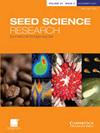白头翁种子发芽潜在机制的转录组测序分析
IF 1.9
3区 生物学
Q2 PLANT SCIENCES
引用次数: 0
摘要
白头翁白头翁白头翁白头翁白头翁白头翁在医药工业中有着广泛的应用。随着临床应用的不断深入,对其植物资源的研究越来越受到人们的重视。然而,白头翁种子发育过程中不同萌发的潜在分子机制仍然是未知的。因此,本研究以外观性状有明显差异的4个萌发阶段的羊草种子为材料。利用转录组测序技术分析种子萌发的分子机制。共检测到27601个差异表达基因(deg)(6个不同的组)。KEGG富集分析显示,上调的DEGs富集于类苯丙烷生物合成、光合作用、光合天线蛋白、植物激素信号转导、类黄酮生物合成等途径。在植物激素信号转导途径中,共富集了87个DEGs,包括生长素(25)、脱落酸(13)、赤霉素(6)、乙烯(9)和细胞分裂素(7)。此外,利用这些DEGs构建了蛋白-蛋白相互作用网络。部分deg经qRT-PCR验证。通过综合分析,初步了解了参与羊草种子萌发过程的植物激素信号转导通路的关键基因。本文章由计算机程序翻译,如有差异,请以英文原文为准。
Transcriptome sequencing analysis revealing the potential mechanism of seed germination in Pulsatilla chinensis (Bunge) Regel
Pulsatilla chinensis (Bunge) Regel has been widely used in the pharmaceutical industry. With the deepening of clinical application, the research on its plant resources has attracted much attention. However, the underlying molecular mechanisms of distinct germination during Pulsatilla seed development are still mostly unknown. Therefore, in this study, four germination stages of P. chinensis seeds, with obvious differences in seed appearance traits, were used as materials. Transcriptome sequencing technology was used to analyse the molecular mechanisms of seed germination. A total of 27,601 differentially expressed genes (DEGs) (six different groups) were determined. KEGG enrichment analysis revealed that the up-regulated DEGs were enriched in phenylpropanoid biosynthesis, photosynthesis, photosynthesis–antenna proteins, plant hormone signal transduction, flavonoid biosynthesis and other pathways. A total of 87 DEGs was enriched in phytohormone signal transduction pathways, including auxin (25), abscisic acid (13), gibberellin (6), ethylene (9) and cytokinin (7). Furthermore, a protein–protein interaction network was constructed using these DEGs. Some DEGs were validated by qRT-PCR analysis. This comprehensive analysis provided basic information on the key genes of plant hormone signal transduction pathways involved in the seed germination process of P. chinensis (Bunge) Regel.
求助全文
通过发布文献求助,成功后即可免费获取论文全文。
去求助
来源期刊

Seed Science Research
生物-植物科学
CiteScore
3.60
自引率
4.80%
发文量
23
审稿时长
>12 weeks
期刊介绍:
Seed Science Research, the official journal of the International Society for Seed Science, is a leading international journal featuring high-quality original papers and review articles on the fundamental aspects of seed science, reviewed by internationally distinguished editors. The emphasis is on the physiology, biochemistry, molecular biology and ecology of seeds.
 求助内容:
求助内容: 应助结果提醒方式:
应助结果提醒方式:


